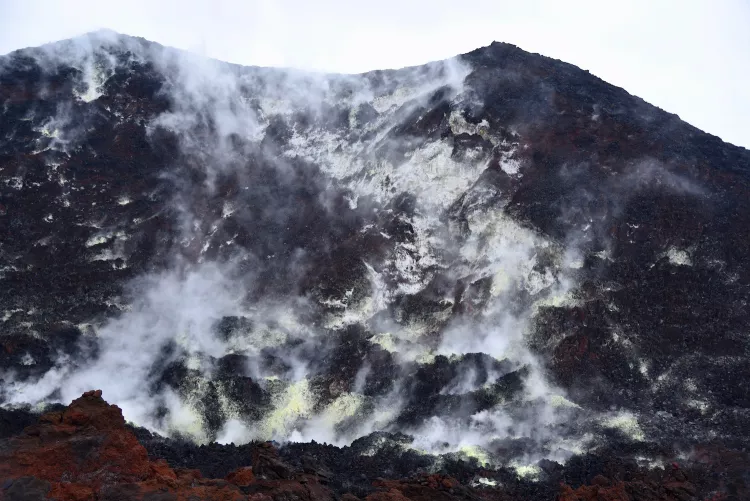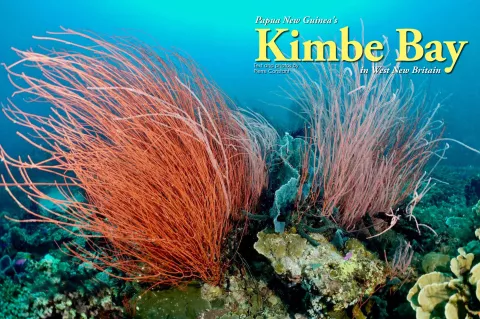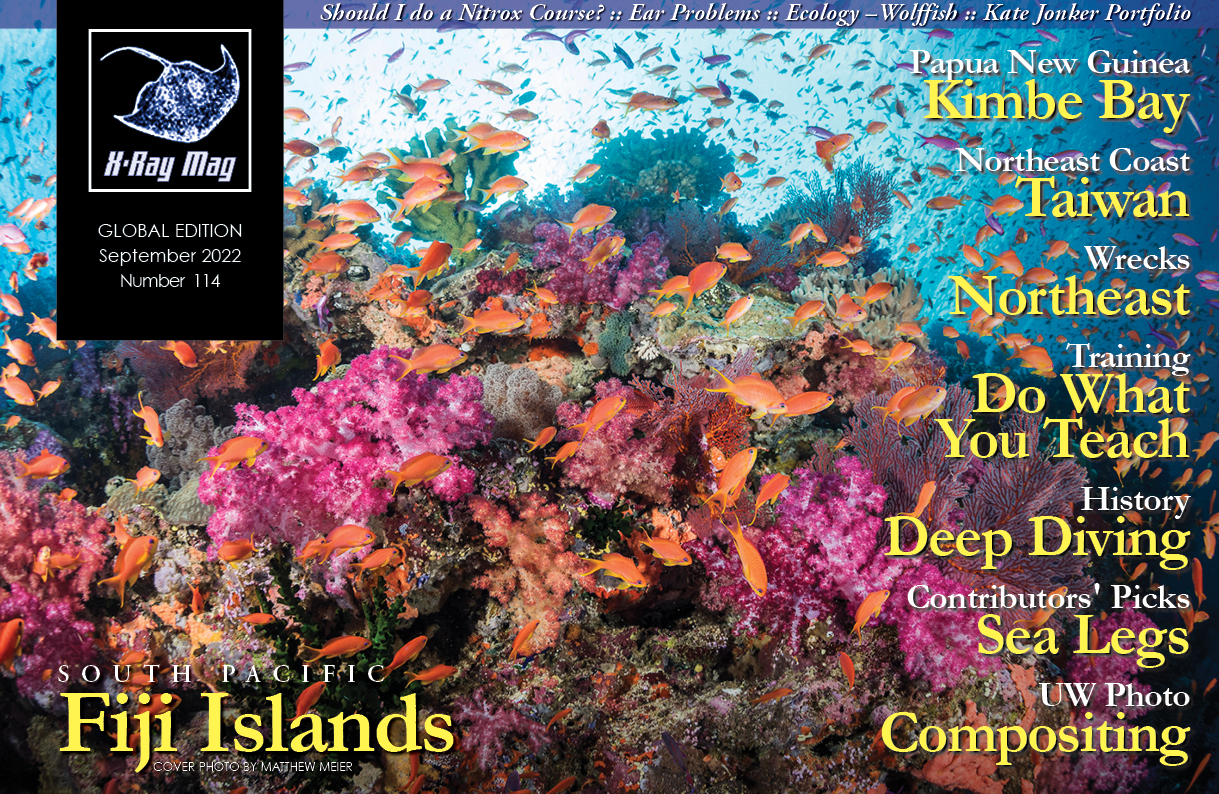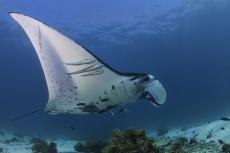Kimbe Bay, located in the West New Britain province of Papua New Guinea, is open to visitors again after two years of pandemic restrictions. What awaits are beautiful dive sites, diverse marine life and coral reefs with great fish action. Pierre Constant shares his adventure there.
Contributed by
Of all the islands of Papua New Guinea, New Britain is certainly the most active volcanically. Reaching 520km in length and 146km in width, it is the largest island of the Bismarck Archipelago with a total land surface of 36,520 sq km. New Britain’s chains of volcanoes are mostly found along the northern coast, around Rabaul in East New Britain, and along the Willaumez Peninsula, around Kimbe in West New Britain. As a whole, however, the 27 volcanoes are aligned all along the length of the island, from the southwest to the northeast.
Geology
In this part of the West Pacific, the tectonic plates configuration is rather complex. A long time ago, the Indo-Australian Plate (in the south) subducted under the Pacific Plate (in the north) at the New Britain/Bougainville/Makaira trench. When the Indo and Australian Plates separated, each moved northwards at a rate of 3.7cm per year and 5.6cm per year respectively (Keren Francis, 2018).
Located in the collision zone between the Australian Plate and the Pacific Plate, the Solomon Sea Plate is a micro-plate, a 250,000 sq km slab of oceanic crust, which is in subduction under both the New Britain and Bougainville islands. Consequently, the Solomon Sea Plate is in subduction under the South Bismarck Plate to the northwest, and this has created the line of volcanoes known today.
Two episodes of volcanic activity occurred: one in the mid or late Eocene (Basaltic and Basaltic/Andesitic), the other one from the Miocene to the present. Reef limestone was deposited in the late Oligocene and early Miocene, followed by andesitic flows in the late Miocene.

History
According to archaeologists, the arrival of humans dates back to 20,000 to 40,000 years before the present. Evidence of early settlements was found at Kupona Na Dari, on Numundo Plantation, 10km west of Kimbe in West New Britain. Obsidian tools and pottery were unearthed from deep ash layers, which revealed at least 14 eruptions.
In the 17th century, explorer Harper Matthew claimed New Britain for the crown of England. However, William Dampier was the first British man to set foot on the island on 27 February 1700, giving the island its name. Whalers from Britain, Australia and America made ports of call during the 19th century, for water, food and wood.
A German protectorate was established over New Britain and New Ireland in November 1884, called Neu Pommern. The island group was renamed the Bismarck Archipelago and integrated into German New Guinea. The northeastern Gazelle Peninsula was converted into plantations of copra, cotton, coffee and rubber.
At the brink of WWI, on 11 September 1914, the Australian Naval and Military Expeditionary Force took over the island, which, together with the German colony, was incorporated in the Territory of New Guinea by mandate of the League of Nations to Australia. The Japanese Marines landed on 23 January 1942 and occupied Rabaul for the next two years. Eventually, the US 1st Marine Division disembarked at Cape Gloucester on 27 December 1943 to invade New Britain.
Today, the indigenous people of New Britain fall into two main groups: the Papuans, who have lived here for tens of thousands of years, and the Austronesians, who arrived 3,000 years ago. At least 50 different languages are recognised on the island.

Getting there
It takes one hour to fly from Port Moresby, the capital of Papua New Guinea, to Hoskins, from which the airport pick-up minibus takes you west to Kimbe and Walindi Plantation Resort. It is a 90-minute ride on a pot-holed road, across vast areas of oil palm plantations.
Walindi has been the highlight of diving Kimbe Bay for the last 40 years now. It comprises stylish wooden bungalows in an attractive garden setting, with big old trees covered in ferns and epiphytes, casuarina trees, palm trees, decorative plants and beds of flowers, not to mention, a manicured lawn.

It is a haven for birds such as the island imperial pigeon (Ducula pristinaria) and the red-knobbed imperial pigeon (Ducula rubricera), which perches itself on tall casuarina trees. Noisy eclectus parrots, which are green if male and red and blue if female, fly above once in a while, as do the rather shy Papuan hornbills (Rhyticeros plicatus). Ravishing common green birdwing butterflies (Ornithoptera priamus Poseidon) flutter around the flowers at any time of the day.
Originally from Perth, where he worked for the agriculture department, Max Benjamin arrived in 1966. He bought Walindi, an abandoned coconut plantation, in 1969 and turned it into an oil palm plantation. As a spearfishing enthusiast, he pioneered all the dive sites of Kimbe Bay. His wife, Cecilie, met him in 1972 and became a dive instructor in 1982. Following a dive trip the couple took to the Red Sea, the idea of a dive resort emerged, which became a reality in 1983.
Since then, Walindi has become internationally renowned through the images of underwater photographers from around the world who have visited it. In the past, when he served as president of the Papua New Guinea Divers Association (PNGDA), Max was often seen at international dive shows and festivals. Sadly, he passed away in 2019, struck by a fulgurant lung cancer. He was succeeded by his son Cheyne Benjamin, now 38 years old, who has a bachelor’s degree in environmental science and ecotourism, with another degree in filmmaking and natural history from Flinders University in Adelaide. Ema, his wife, has a bachelor’s degree in hotel management.

Diving
Run by friendly Oscar, the dive centre manager, and his team of dive guides and divemasters, the Walindi dive centre conducts two to three dives per day, depending on the number of divers, interests and requirements. There are about 25 dive sites, located on the eastern side of the Willaumez Peninsula, under the towering volcanoes, such as Wangore stratovolcano (1,155m). These are mostly isolated reefs.
Farther away, in the northern or eastern areas of Kimbe Bay, are a number of seamounts with usually crystal-clear waters and great fish action. These were, by far, my favourite dives for their enchanting schools of fish. However, these sites can be a one-hour boat ride away, whereas most reef dives were 30 to 45 minutes away; however, visibility at the nearer sites was often affected by the presence of rivers at the Willaumez Peninsula.

Vanessa’s Reef. One of the closest dive sites, Vanessa’s Reef, is mostly a slope dive. A colourful place for giant sea fans, bushes of red whip corals (Ellisella sp.), undulating gracefully like strands of hair in the mild current. At Kimbe Bay, being a paradise for sponges, one will be delighted by its elephant ear sponges (Ianthella basta), pale blue rope sponges, spiky blue sponges, barrel sponges and voluminous ear-shaped orange sponges. Yellowback fusilier and chevron or blackfin barracuda (Sphyraena qenie) complete the scene, with magnificent sea anemone (Heteractis magnifica) housing pink skunk anemonefish. Oblivious to my presence, a mimetic and photogenic crocodilefish was dozing off on the sea floor.
Katherine’s Reef. This is a triangular reef pointing northwest, with sheer walls on the eastern and southern sides. Swimming around is no problem and allows you to discover caves and overhangs. A great place to see nudibranchs, I came across Aegires serenae, a nudibranch sporting greyish green and yellow colours, with a cross of appendages on its back; as well as Chromodoris lochi in pale blue, with two black lines along the back, and white or pink rhinophores and gills.

The southern wall had four different species of anemonefish, including orange-fin (Amphiprion chrysopterus), Clark’s (Amphiprion clarkii), false percula clownfish (Amphiprion ocellaris), pink skunk anemonefish (Amphiprion perideraion) and spinecheek (Premnas biaculeatus). Schools of striped fusiliers and yellowtail fusiliers (Caesio cuning) cruised along. A granulated sea star (Choriaster granulatus) was seen on a reef wall.
Restorff Island. Restorff Island has two different dive sites with spotted garden eels (Heteroconger hassi), which have two black spots, on the sandy floor; spearer mantis shrimp in their burrows; cushion stars (Culcita novaeguinea); Sarasvati anemone shrimp (Periclimenes sarasvati) on soft corals; a collection of magnificent sea anemones; and an attractive school of long-spot snapper (Lutjanus fulviflamma). Lucas, the divemaster, even spotted two mandarinfish in the coral rubble, though they were very shy.
Restorff Island is the chosen anchorage for midday picnics, which take place near a white sandy beach. Covered with lush jungle, the island teems with different species of pigeons, which coo at all times. Species include the island imperial pigeon (Ducula pristinaria) and the yellowish imperial pigeon (Ducula subflavescens). Brahminy kites in reddish brown and white nest on the island and fly above regularly. I also witnessed a beach stone-curlew (Esacus magnirostris), rather weary of our presence, which had laid a big, speckled egg on the edge of the beach.

Inglis Shoal. Slightly oval in shape with a bump on the eastern side, this seamount rose up from the deep to about 4m below the surface. It comprised mostly slopes on all sides, up to 24 to 28m, when it turned into steep walls. Fish action was just ideal here, with a swirling school of barracudas, often mixed with bigeye jacks, sleek or bluespine unicornfish (Naso unicornis), Vlaming’s unicornfish (Naso vlamingii), black snapper (Macolor niger), bluefin jacks and the odd school of pinjalo snapper (Pinjalo lewisi) in crimson red.
The roundhead parrotfish (Chlorurus strongycephalus) was present, as well as the pretty black stripe or Fowler’s surgeonfish (Acanthurus fowleri). Four cuttlefish (Sepia pharaonis) also showed up on this dive. Although rather shy, a school of oceanic triggerfish (Canthidermis maculatus) hovered in the blue. On a second occasion, I discovered a highfin coral grouper (Plectropomus oligacanthus), hiding in a small cave.
North Ema’s Reef. Being close to the mainland of the Willaumez Peninsula, east of Mt Wangore volcano, this site had poor visibility. However, I managed to encounter a young hawksbill sea turtle. The highlight of the dive, at a depth of 10m or so on the wall, was a white bonnet anemonefish (Amphiprion leucokranos), which is endemic to both Papua New Guinea and the Solomon Islands.

Bradford Shoals. One hour away from Walindi, straight to the north, this seamount was simply fascinating, due to the clear waters and amazing fish action. We followed the mooring line down to the top of the reef at 21m. Right away, we were met by a large school of bigeye jacks, with a nearly similar-looking species of fish, very unfamiliar to my eyes. It turned out to be the whitetongue jack (Uraspis helvola), which is distinguished by a low inconspicuous dorsal fin and silvery body with dark chevron bars on the sides. The species is noted to be rare in the Asian Pacific region. Just below, a group of teira batfish (Platax teira) cruised about, rather shyly though, some of which had no apparent black dot next to the pectoral fin. Two large-sized dogtooth tuna suddenly zoomed in, creating instant panic among the fish schools. The orange-fin anemonefish differentiated itself from the Clarke’s anemonefish (A. clarkii) by its white tail. Circumnavigating the seamount was easily done during the course of the dive.

Japanese Zero plane. This wreck is located in a sheltered bay at the foot of Mt Wangore. On a soft volatile bed of brown silt in 15 to 17m of water, this iconic aircraft was only discovered in the year 2000 by local fishermen. Produced on 21 August 1942, this Japanese Zero fighter plane was part of Airgroup 204, which left Rabaul on 27 December 1943, while the US 1st Marine Division was disembarking at Cape Gloucester, on the southwestern tip of New Britain. Apparently due to a technical problem, pilot Tomi Haru Honda landed the plane in shallow waters near the Willaumez Peninsula.

Lacking any markings, the Zero was intact and now covered in grey encrusting sponges, which wrapped the fuselage like a shroud or spider web. Only the propeller had conspicuous red sponges and some bubble coral on it. Dive guide Brian acted as a model on the initial dive and divemaster Andrew posed on the wing on a subsequent dive. In his company, I explored a nearby reef, where he pointed out a magnificent starry polyclad flatworm (Acanthozoa sp.).
Joelle’s Reef. Just 45 minutes north of Walindi, this seamount had an elongated bean shape, with a curved tip to the southwest. Pinjalo snapper (Pinjalo lewisi), bigeye jacks and bluefin jacks were on the menu. Leaf coral mounds were conspicuous in places, as well as venomous patches of elephant ear anemone or corallimorpharia (Amplexidiscus fenestrafer) in big attractive plates—not to be touched, by any means! The top of the reef, at 16m, sloped down to 25 or 30m, before a vertical drop-off. Barrel sponges and big gorgonian fans were found on the eastern side.

Joy’s Reef. This site comprised a sandbar and coral rubble, emerging on the surface, which attracted arctic terns (Sterna paradisaea) and greater crested terns (Sterna bergii), which came to clean themselves in shallow water. Close to shore, and thus having poor visibility, this site was nevertheless a convenient macro dive, where one could spot the signal or twin-spot goby (Signigobius biocellatus) or the Pott’s crinoid shrimp (Palaemonella pottsi). There were also some Phyllidiella sp. nudibranchs, red-lined sea cucumbers (Thelenota rubralineata), Hefferman’s starfish (Celerina heffernani) and red-banded sea star (Gomophia gomophia). There was a great variety of attractive coral species, including the anemone coral (Goniopora djiboutiensis) and broccoli-style bubble or torch coral (Euphyllia glabrescens).
Otto’s Reef. Named after a German fellow of the old days and 45 minutes from Walindi towards the Wulai Islands, this isolated reef rose up from the deep in the middle of Kimbe Bay, far from any land. Jutting out towards the east, a reef point underwater attracted lots of fish action. For a change, I got to encounter three grey reef sharks up close. One of them was encircled by a school of rainbow runners (Elagatis bipinnulatus) in tow. It was a good photo opportunity, but unfortunately too deep.

Also noticeable here was the presence of mackerel scads (Decapterus macarellus) together with the rainbow runners, a favourite food of dolphins. A giant trevally or jack (Caranx ignobilis) zoomed in on me for a closer look, and a school of oceanic triggerfish hovered in the blue like fluttering butterflies.
Otto’s Reef was good enough for two dives, as the wall curving around the point to the south was full of caves and overhangs. Slender unicornfish (Naso lopezi), barracuda, bigeye jacks and Napoleonfish or humphead wrasse were present.
Night dives. Night dives were done from the pier off the dive centre, or a site just a couple of minutes away by boat, on a nearby reef. As expected, these sites were a mixture of muck—very fine volcanic silt—and patches of coral.

Here, one may encounter mantis shrimp in their burrows or on an outing, box crab, the sawedged spooner crab (Etisus utilis) and scorpionfish on the seafloor. Lots of Lampert’s sea cucumber (Synaptula lamperti) were seen here, on sponges. Even the elusive mimic octopus (Thaumoctopus mimicus) was spotted.
Andrew pointed out a charming Glossodoris hikuerensis nudibranch on a brown sponge. However, my most incredible find was a giant nudibranch (20cm), a species I have never seen before: the lumpy asteronotus, a dorid nudibranch (Asteronotus cespitosus), which was mauve to light brown in colour, with warts and a ridge on its back, plus pink gills and rhinophores—an absolutely amazing creature!

Post-pandemic plans
Papua New Guinea was closed for two years due to Covid-19, and only reopened its borders in early 2022, when Australia did. No Covid test is necessary any longer upon arrival, but the vaccination certificate is compulsory. Logically, tourism suffered from the closure, but Walindi is slowly operating again as bookings have increased a great deal this year.
General manager Cheyne Benjamin has new plans for improving the resort and bungalows, and a new swimming pool overlooking the beach was actively under construction during my stay. Facing the sunrise and the placid waters of the bay, it will look great.
Although retired from active duties, Cheyne’s mother Cecilie turned out to be a good nurse and would help anyone with health problems, or with infected cuts—as she did for me—with a Papua New Guinea-made antibiotic cream that worked wonders on a bad-looking wound on my ankle. She was also a good source of information on the history of New Britain.

Rabaul
No trip to New Britain would be complete without a visit to Rabaul—a deep seaport that was once upon a time considered to be the “Pearl of the Pacific.” This vision of prosperity sadly does not exist any longer, since the dramatic volcanic twin eruption of 1994. The old town was totally destroyed, burnt and buried in ashes. I had come to Rabaul in 1990 and again in 1991. On both occasions, I climbed the “volcano” on Matupit Island. Back then, you needed a canoe ride to cross the bay.
Thirty-two years later, I was keen to see the changes. A new town had emerged west of the old one, which was flattened and now, history. Isolated on the outskirts like a ghost of the past, Rabaul Hotel was still standing and operating, next to a big tree conspicuously noisy with a colony of nesting metallic starlings. One good point, however, was that it was a convenient stop on the way to the volcano.

No longer an island, Matupit is now accessed by a land bridge. “It is only a 20-minute walk,” I was told. In fact, it turned out to be nearly a 1.5-hour trek to the summit of Tavurvur. A dirt road led through a desolated landscape of volcanic ash and black sand, punctuated by sparse vegetation, lone trees here and there, tufts of bamboo and pandanus trees with big spiny green leaves hanging down. A bamboo barrier marked the end of the way, with a small signboard that read “Site fee 5 Kinas.”
The volcanic trail fringed the seashore, winding among hot springs and pools of steaming water. On continuation, there were pockets of lava flow, mostly covered by volcanic tuff (pebbles resulting from a volcanic eruption of lava mixed with water), until the start of the real steep climb.
Black in colour, Tavurvur volcano was a mix of basalt and tuff, with a slippery snaky trail up to the rim. From the top, the view of the 150m-wide crater was that of a cauldron, steaming profusely with solfataras on all sides, at the base of which sulphur deposits were conspicuous. Due to oxidation and heavily fractured in concentric rings, the basalt had turned an orange brown—a biblical window to hell, for sure!
Not as serious as the former one, the latest eruption of Tavurvur, involving earthquakes, occurred in 2014. The new capital of East New Britain has moved to Kokopo, east of the Gazelle Peninsula. The next eruption is not expected before 2034. The Pacific war may be over for almost 80 years and long forgotten, but the sword of Damocles is still hanging over Rabaul, no matter what.
Special thanks go to Walindi Plantation Resort owned by the Benjamin family (walindiresort.com).










































